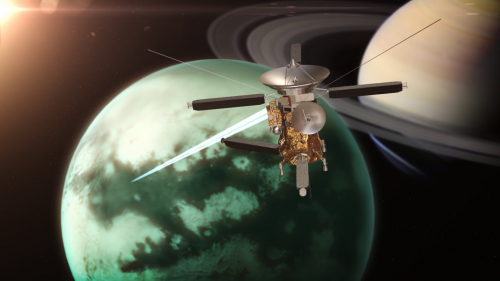An Extraterrestrial Submarine
On a moon of Saturn called Titan, a dragonfly hovers over the equator, while a turtle ripples the surface of Kraken Mare, a sea of liquid methane. Surviving in temperatures below -300 °F, these aren’t hardy new lifeforms, but machines—Titan Turtle, a submarine, and Dragonfly, a drone, are collecting and relaying information about Titan’s environment back to Earth. This is a scene that a team of scientists from NASA and several universities hope to create by the 2040s, and new research simulating the conditions of Titan’s seas suggests it might not be as outlandish as it sounds.
In such an extreme environment, scientists have to rewrite the whole engineering rulebook. Thiss research aimed to understand some of the challenges posed by Titan’s conditions. “The bottom line is, we don’t know a lot about the seas,” said Steven Oleson, the lead of the Compass Concurrent Spacecraft Design Team at NASA’s John H. Glenn Research Center.
In order to fill that gap in knowledge, Ian Richardson of Washington State University and Jason Hartwig of NASA had to generate a test version of Kraken Mare in the laboratory. But they didn’t have to look far for the technology—modern rocket fuel chambers also hold extremely cold mixtures of liquids, so the researchers were able to modify an existing apparatus used for fuel experiments. The key to producing the low temperatures is a pulse tube cryocooler, which generates very cold helium gas to cool the methane and ethane test chamber.
One potential problem faced by the submarine is the large amount of nitrogen dissolved in the methane and ethane sea. If the submarine perturbed the fluid enough, nitrogen could bubble out of solution like gas from a shaken soda can, disrupting the submarine’s function. To test for this possibility, the researchers introduced a two-inch, heated metal cylinder into the test chamber—a simple, miniature model for the Titan Turtle. Observing the fluid at different pressures, temperatures and nitrogen concentrations, they found the submarine’s heat alone is not enough to cause nitrogen dissolution.
Nitrogen solubility is but one of many challenges to contend with in Kraken Mare. How should a submarine carry out measurements and capture images at -300°F? And how should it autonomously avoid methane icebergs that could either sink or float, depending on the conditions? These are questions the researchers hope to answer prior to the 2030s, when the submarine would ideally launch for Titan, reaching Kraken Mare in the 2040s.
Titan may hold answers to some of the most important questions facing astronomers. Observations from the European Space Agency’s Huygens probe, which landed on Titan in 2005, revealed that it is rich in complex organic molecules, the building blocks of earthly life. More detailed observations could illuminate how these molecules might have formed early in Earth’s history and on other planets. Titan is too cold for water-based life, but according to Oleson, “The potential for a different kind of life is not impossible.”
Moons thought to have aquatic oceans, such as Enceladus and Europa, may have a greater potential for life swimming beneath their surfaces, but unfortunately their oceans are covered in miles of ice. While missions on these moons would face the significant hurdle of drilling to the subsurface oceans, the Titan Turtle could be delivered to Kraken Mare using a parachute, a technology already proven to work with the Mars Curiosity rover. Given the accessibility of Titan’s seas, the Titan Turtle and Dragonfly probably wouldn’t be lonely. “If things go well and Titan becomes of extreme interest,” Oleson said, “One could imagine you could have orbiters there, balloons, rovers—all kinds of things.”

